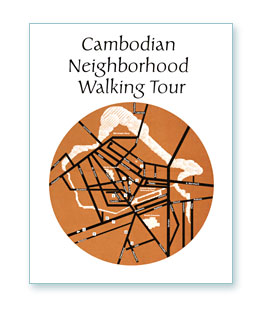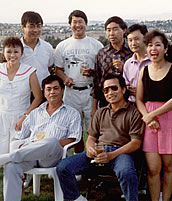There was no concentrated population of Southeast Asians in the United States before 1975. The early refugees were dispersed across the country by the U.S. government. In hindsight, however, this policy went against the best interests of the refugees. Starting in the late-1970s, refugees ignored the government’s guidelines and began congregating in neighborhood and commercial clusters.
 New Ethnic Communities New Ethnic Communities
These ethnic enclaves provide most of the goods and services that community members need or want. Thus they have become cultural havens where refugees feel comfortable communicating in their ethnic language and can create crucial support networks. Some communities, both residential and commercial, cover city blocks in urban areas, while others occupy mini-malls in suburban locations or one main street in rural areas. In some instances, Southeast Asians have started new ethnic communities and, in other cases, they joined already existing Asian American communities. For example, ethnic Chinese groups from Southeast Asia have opened businesses in historically Chinese American commercial districts.
Although they were originally dispersed across the country, refugees began relocating to sites where social services were suitable, jobs were available, housing was affordable, educational opportunities were accessible, weather conditions were more to their liking, ethnic materials and services were plentiful, and family and friends lived nearby. These ethnic communities, often known as Little Saigon or Little Phnom Penh, have been crucial in helping the first generation adjust to life in the United States and are protective places for those who faced harsh racial discrimination in other U.S. sites. This is especially true for those with limited English language skills. These ethnic sites have provided a place to start non-profit organizations, organize cultural celebrations, construct religious centers, and hold community meetings. Members have also established leisure spaces within these communities, such as cafés, cyber cafés, karaoke clubs, nightclubs, and billiard halls.
Resolving Tensions
Southeast Asian Americans have experienced resistance from long-time residents who complain that Southeast Asians are taking over their neighborhoods. According to ethnic business owners, these residents, along with their political and economic supporters, have tried to prevent additional businesses from opening, grumbled about the use of ethnic language signs, and created an unfriendly business climate. In some cases Southeast Asians have clashed with African American, Latino, or Anglo residents who resent the presence of numerous Southeast Asian residents or businesses, especially in densely populated low-income areas.
Efforts to negotiate tense relations between these groups are ongoing. As Southeast Asian American communities grow in political power and gain economic clout, they have become better able to counter discriminatory measures by local officials and to advocate for favorable policies. These commercial districts continue to prosper. In the future, however, as the number of new immigrants dwindle, community leaders are concerned with how they will survive economically if the younger generations do not feel connected to the ethnic communities. Some leaders have discussed the feasibility of attracting other Asian and non-Asian tourists to their commercial areas, as Chinatown sites have done.
Continued on page 2 |
<< Back |
[1] 2 |
Next >> | |


 New Ethnic Communities
New Ethnic Communities